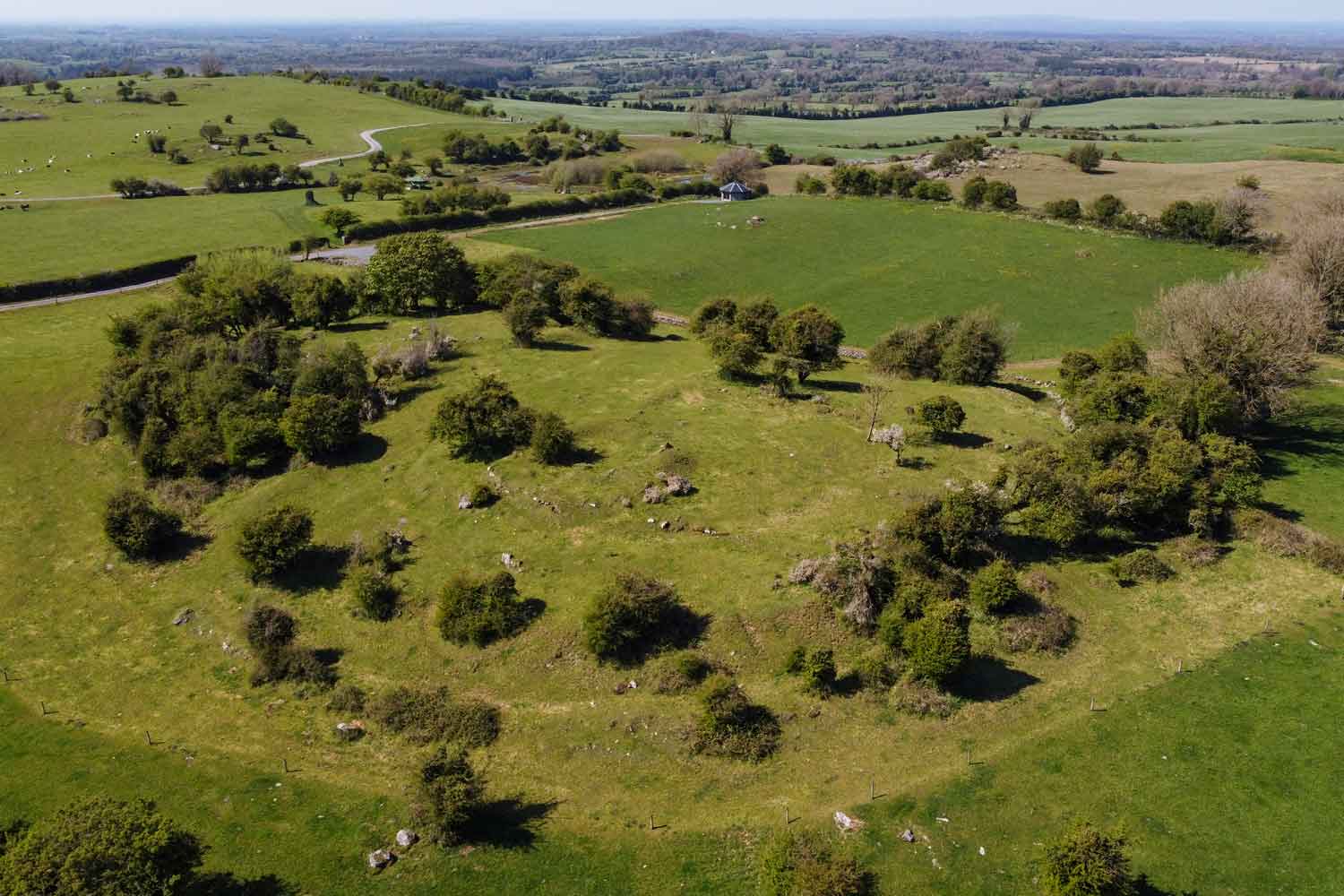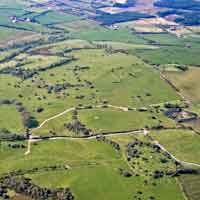Rathnew Ringfort (The Palace)

Location: Rathnew, Co. Westmeath
Classification: Ringfort - Rath
SMR Code: WM024-066----
Rating:
Known locally as 'The Palace', Rathnew Ringfort is the largest monument on the Hill of Uisneach and occupies a commanding position on a prominent rise (175m above sea-level) about 500m southeast of the summit. This conjoined (figure of eight) ring fort is 80m (E-W) by 110m (N-S) and consists of a large, subcircular enclosure with a smaller, semicircular enclosure conjoined to its western side. The Palace was the subject of a major archaeological excavation in the 1920's which revealed the remains of several houses, two souterrains and various other features associated with domestic occupation spanning several centuries. There is also an ancient road running up to it from the south which is still visible. The ringfort was excavated in 1925-8 by R. A. S. Macalister, who believed it to be one of the palaces of the legendary King Tuathal Techtmar from the First Century AD.
Research into the site have shown there were three main structural phases during its long period of usage. The first is a prehistoric ceremonial enclosure (22m diameter) which is variously dated to the Late Bronze or Early Iron Ages with evidence of periodic feasting and fires. The next phase is the early medieval conjoined ringfort, the remains of which, along with a later Medieval field system (3rd Phase), are most evident today. The changing role of the site from ceremonial sanctuary to high-status settlement indicates that the conjoined ringfort was a 'royal', residence of the Clann Cholmáin 'Kings of Uisneach' and later kings of Mide.
According to legend the ringfort at Uisneach was one of the palaces built by Túathal Techtmar, a mythical high king from the 1st century AD (see Associated Characters below). The exiled son of a deposed king, Túathal returned at the head of an army to reclaim his father's throne. Túathal then created the Kingdom of Mide by taking land from each of the four provinces. It is said that he built four palaces/forts in Mide/Meath: Tlachtga, on land taken from Munster; Tailtiu, on land from Ulster; Tara, on land from Leinster and Uisneach, on land from Connacht.
Description
Known locally as 'The Palace', Rathnew Ringfort is the largest monument on the Hill of Uisneach and occupies a commanding position on a prominent rise (175m above sea-level) about 500m southeast of the summit. This conjoined (figure of eight) ring fort is 80m (E-W) by 110m (N-S) and consists of a large, subcircular enclosure with a smaller, semicircular enclosure conjoined to its western side. The Palace was the subject of a major archaeological excavation in the 1920's which revealed the remains of several houses, two souterrains and various other features associated with domestic occupation spanning several centuries. There is also an ancient road running up to it from the south which is still visible. The ringfort was excavated in 1925-8 by R. A. S. Macalister, who believed it to be one of the palaces of the legendary King Tuathal Techtmar from the First Century AD.
History
Research into the site have shown there were three main structural phases during its long period of usage. The first is a prehistoric ceremonial enclosure (22m diameter) which is variously dated to the Late Bronze or Early Iron Ages with evidence of periodic feasting and fires. The next phase is the early medieval conjoined ringfort, the remains of which, along with a later Medieval field system (3rd Phase), are most evident today. The changing role of the site from ceremonial sanctuary to high-status settlement indicates that the conjoined ringfort was a 'royal', residence of the Clann Cholmáin 'Kings of Uisneach' and later kings of Mide.
Folklore
According to legend the ringfort at Uisneach was one of the palaces built by Túathal Techtmar, a mythical high king from the 1st century AD (see Associated Characters below). The exiled son of a deposed king, Túathal returned at the head of an army to reclaim his father's throne. Túathal then created the Kingdom of Mide by taking land from each of the four provinces. It is said that he built four palaces/forts in Mide/Meath: Tlachtga, on land taken from Munster; Tailtiu, on land from Ulster; Tara, on land from Leinster and Uisneach, on land from Connacht.
This monument is part of a Complex

This monument is part of a Complex

Accessibility Rating: Easy - Moderate
Access to any of the monuments on the Hill of Uisneach is by guided tour only. Please visit www.uisneach.ie for more details or telephone +353 (0) 87 718 9550
Visitor Centre & Carpark.
Accessibility
Accessibility Class: Easy - Moderate
Access to any of the monuments on the Hill of Uisneach is by guided tour only. Please visit www.uisneach.ie for more details or telephone +353 (0) 87 718 9550
Facilities
Visitor Centre & Carpark.
Map
Users should note that the Monumental Ireland application and website are information guides only and do not act as an invitation to enter any of the properties or sites listed. No responsibility is accepted by the creators of the Monumental Ireland application for any loss, injury or inconveniences sustained as a result of using it.






